|
The
“movistar” was launched in the Marin Military Naval
Academy Sanxenxo, 28th of October 2005
The
Marin Naval Academy is the venue chosen by the
“movistar” team for the official launch
of the Volvo Open 70 they are to sail in the Round the
World Race 2005-2006. The event is set to
take place today, Friday 28th of October, at
16:30 hours, scarcely a week before the competition
starts in Sanxenxo, with the first ever coastal regatta
in the history of the Volvo Ocean Race.
“The
Marin Naval Academy was a natural choice
–remarks Pedro Campos, managing director
of the Spanish team–, first of all because
it is an emblematic institution in the
naval history of Galicia and Spain. All those who love
the sea are familiar with and respect the tradition of
the Marin Naval Academy and for me personally, it
is a great honour that our boat can be
christened in its facilities. On
the other hand, the strategic position
of Marin was critical; right
in the Pontevedra Estuary, where the
team has its base, and half way between Sanxenxo and
Vigo. Moreover, ever since we weighed up this
option, the people running the Academy have bent over
backwards to help us”.
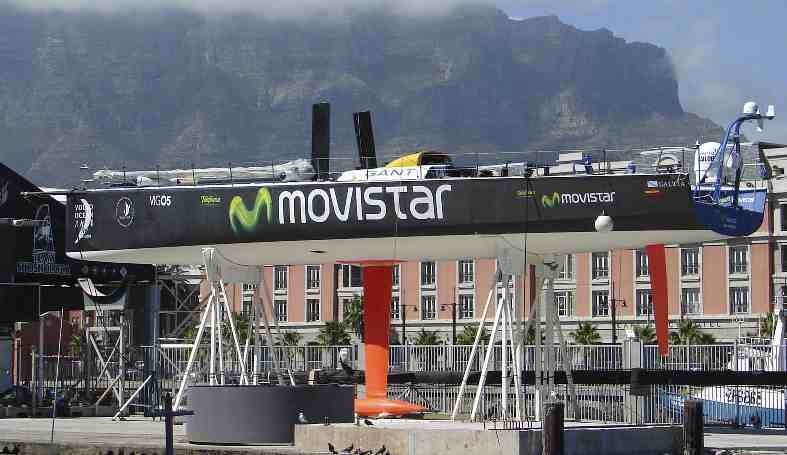
The
launch, attended by Admiral Jose
Antonio Gonzalez Carrion, will take place at
16:30 hours and it will be
open to the public. “An excellent opportunity
for people to visit a lovely place like the Naval
Academy –continues Campos–, and
while they are there, they can get a
first hand idea of what a Round
the World boat like the “movistar” is really
like. Once again, I am grateful for the
efforts and the support offered by the
Academy, which has agreed to open its doors to enable us
to share this celebration with whoever would like to
come along”.
The
“movistar” will have a special God
Mother for the launch. Esther Cid Cadavid, the
wife of Emilio Perez Touriño –President of the Xunta
de Galicia (Galicia Regional
Government)–, has been chosen to crack the
bottle of “alvariño” wine on the
hull of the Volvo Open 70 “movistar”,
when it is christened with the name “Galicia”. Both
the name and the flag of Galicia will
appear on the hull of the boat for its voyage of
over 57,000 kilometres around the world, starting on
November 5th.
Anxela
Bugallo, Minister of Culture and Sport of the
Galicia Regional Government, will also
attend the event on behalf
of the Galician Government, accompanied
by the Director General of
Sports, Santiago Dominguez, the Mayors of
Marin, Pontevedra, Sanxenxo and Vigo, and with Admiral
Jose Antonio Gonzalez Carrion,
director of naval studies, and Commander Javier
Franco Suances, Director of the Academy,
hosting the event at the Marin Naval Academy.
Sailing/Round
the World: Damage forces the Volvo Open 70 movistar to
head for shore.
The damage occurred after an enormous leap from a wave
500 miles from land, in the open sea off Lisbon. Damage
forces the Volvo Open 70 “movistar” to head for
shore.
Sanxenxo (Pontevedra), 13th of November 2005.
After a promising start, and when the Volvo Open 70 was
sailing at full potential in a heavy downpour and in
close competition with the Dutch boat, ABN-AMRO One,
nearly 60 miles ahead of the rest of the fleet after a
mere 12 hours of the competition, the boat leaped over a
wave and slammed back down into the sea, causing
structural damage to boat. The damage affected the work
load of the pivoting keel’s hydraulic system.
For reasons of safety, the team is forced to set course
for Cadiz (Spain) in an attempt to repair the damage.
The decision was taken after passing the latitude of
Lisbon (Portugal) at 10:00 a.m. (Spanish time), when the
Spanish boat was 300 miles from the port of Cadiz.
The entire shore team has set off from their base in
Sanxenxo for Cadiz.
Ana Garcia
movistar Press Team
Office: +34-91-398 4738 / 669 16 59 91
E-mail: ana.garcia@ogilvy.com
Traditionally
the Volvo Ocean Race race has always begun in the
UK. The first major change comes with the
inclusion of Vigo as the start port, details of which
will be published nearer to the start of the event.
After an inshore race in Sanxenxo, Galicia, the
first leg will start from the
neighbouring port of Vigo and take the fleet south, via
a scoring gate at Fernando
da Noronha, on the Brazilian
coast, to Cape Town, South Africa. Cape Town has been a
natural part of previous races given its geographical
location where two of the world's great oceans meet, and
thereby a logical destination for leg one.
Leg two
will be the first test of the Southern Ocean.
Historically, the event has always been known and
respected for its long ocean legs, taking the event far
south into the Southern Ocean. It is racing across this
lonely ocean that allows the sailors to use their
experience and push their boats to the limit and it is
generally considered to provide the most exciting ocean
racing in the world. To make it even more exciting, we
have introduced a scoring
gate at the Kerguelen Islands
and another at Eclipse
Island, off Albany on the west
coast of Australia. The leg finish will be in Melbourne,
Australia.
Leg three
will take the fleet to Wellington for a pit-stop.
Instead of the rolling start as seen in the Hobart
pit-stop in the last edition of the race, the boats will
start from Wellington as a fleet, beginning leg
four, which takes them back
into the Southern Ocean and around the infamous Cape
Horn, which will also be a scoring gate,
before the hot slog up to the leg finish in Rio de
Janeiro, Brazil. South America has been a part of the
race since its conception in 1973, and we are pleased to
continue the tradition of stopping in this important
world market place.
Leg five
will go direct to Baltimore, missing out a stopover in
Florida, but with the inclusion of a scoring
gate at Fernando da Noronha. Leg
six will start from Annapolis
as in previous years and take the fleet on a short leg
to New York, which is another new port for the Volvo
Ocean Race 2005-2006. Leg
seven will start from New York
and will set the fleet up for a crack at the Blue Riband
transatlantic record from the Ambrose Light to
the Lizard off the south western coast of England
(which will also be a scoring gate), before finishing
the leg in Portsmouth.
Leg eight
will send the fleet westwards through the English
Channel and around Irland and the north of the UK to
finish in Rotterdam, Holland.
And finally the fleet will sail the
ninth leg from Rotterdam to
Gothenburg in Sweden , the home of Volvo and the scene
of huge support during the last event.
|
In
Port Races
|
|
|
|
|
|
SANXENXO
(GALICIA)
|
5-Nov-05
|
|
|
|
|
CAPE
TOWN (SOUTH AFRICA)
|
26-Dec-05
|
|
|
|
|
MELBOURNE
(AUSTRALIA)
|
4-Feb-06
|
|
|
|
|
RIO
DE JANEIRO (BRAZIL)
|
25-Mar-06
|
|
|
|
|
BALTIMORE/ANNAPOLIS
(USA)
|
29-Apr-06
|
|
|
|
|
PORTSMOUTH
(UK)
|
29-May-06
|
|
|
|
|
ROTTERDAM
(NED)
|
11-Jun-06
|
ABOUT
GALICIA, SPAIN
Galicia
looks out over the Atlantic Ocean and the Bay of Biscay
with over two thousand years of history behind it.
Largely undiscovered by foreigners, it is very
picturesque and mostly unspoilt. It also offers some of
the prettiest Spanish landscapes.
To
explore these lands in the north-west of Spain means a
chance to live the adventure of a lifetime, full of
tradition, lush landscapes and unique cities. In Galicia,
the frontiers between sea and land cancel each other
out. Both blend together along the 1,300 kilometres of
coastline, 772 beaches, and five large rias (long sea
lakes that stretch inland) where, tradition has it, the
right hand of the Creator shaped the dramatic coastline
that now defines part of this land.
A
traveller coming to Galicia soon discovers that, in this
territory situated in the north-west of the Iberian
Peninsula, over two thousand years of history have
endured. Local history offers every visitor its
enigmatic castros (Celtic dwellings) with their peculiar
citadels; and in them, perhaps, discover the Celts,
ancient occupants of an evocative granite world (the
castros at Baroña -Porto do Son-, Viladonga -Castro do
Rei- or Santa Tegra -A Guarda- are the best-preserved).
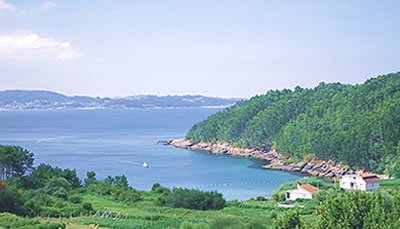
The
traveller can also see Gallaecia, the Roman Galicia. The
great Roman Wall in Lugo is still standing, a unique
fortified enclosure with a circular structure and a
perimeter of 2,200 metres lasting since the 3rd century.
Something different is immediately noticeable here.
Clear connections with the Celtic peoples are to be seen
in this fertile land. Galicia is also the land of a
thousand rivers. Water runs into many of them off the
mountains of Os Ancares, O Courel or Peña Trevinca
(with altitudes over 1,800 metres).
Mountains, lush valleys and the most dramatic piece of
coastline you are likely to find in Spain can be found
in the four districts which make up the region. The
district of Orense is by far the most mountainous with
peaks reaching up to 1800m.
The
friendly ‘gallegos' have many reasons to be so proud
of their homeland, for here in this north-western pocket
of the Spanish mainland lies a rich region of great
diversity, where a scenic coastline, shaped by
fjord-like ‘rías', meets an abundant land of wooded
slopes and pretty stone villages, interrupted every now
and then by the impressive silhouette of a historic
city.
It
is on and around the spectacularly indented coastline of
the Rías Baixas that many of our properties are to be
found. Here, the three estuaries or drowned river
valleys of Vigo , Pontevedra and Arousa have carved a
shoreline of wide sweeping bays and sheltered beaches of
golden sand, whilst their calm waters are the source of
some of the finest seafood in Europe. At the point where
the Ría de Vigo meets the river, daily
catches, mainly of oyster and mussel, are hauled onto
the shores of the ‘seafood capital' of Arcade ,
later to be auctioned in the adjacent market. Naturally,
it is this that dominates the menus of the restaurants
that line the streets behind. Further down, from the
well kept lawns and long sands of Cesnantes ,
views across the water encompass the lush wooded slopes
that line the opposite shore.
In
the nearby Ría de Pontevedra , a
wander up the forested hillside that backs the bustling
coastal town of Sanxenxo reveals the
impressive panorama of seascape, punctuated by the
imposing outline of the protected islands of Ciés
and Ons , which are home to
long sweeping beaches of fine white sand and a haven for
birds. Around the corner in the local fishing port of Portonovo
, details of the freshly caught fish once again
fill the menu boards of the adjacent restaurants.
‘Empanada
de berberecho', a pie of smooth, light pastry
filled with cockles, seafood croquettes, ‘pulpo a la
gallega', octopus in paprika and olive oil, and a
mouthwatering range of freshly caught fried fish are
some of the many dishes that tempt the passer-by.
Continuing northwards, the road soon turns a corner to
reveal the long majestic sands of A Lanzada ,
where dunes and open grassland form the backdrop, with
not a building in sight. Beyond, a bridge now joins the
mainland to the idyllic island of A Toxa ,
home to the fishing town of O Grove and
famed for its ‘conchas' or shellfish, which are served
in their shells and combined with a delicious mixture of
finely chopped onion and pepper.
LANGUAGE
Spanish
was imposed as the only official language for several
centuries. Since the end of the 20th century,
the Galician language has also an official status, and
both languages are taught in Galician schools. There is
a strong social movement to preserve the Galician
language.
The
Galician and Portuguese languages are derived from the
early Portuguese-Galician (Galego-Português)
language. In the Middle Ages, the Galician and
Portuguese languages began to diverge because of the
political separation of Portugal from Galicia. Today,
they constitute different languages with different
grammatical rules and official academies and
institutions. There remain many similarities between
Portuguese and Galician. Orally, these differences are
about as much as between Flemish — a form of Dutch
spoken in Belgium — and standard Dutch.
A
distinct Galician Literature emerged after the Middle
Ages. In the 13th century, important contributions were
made to the romance canon in Galego-Português. The most
notable was by the troubador Martín Codax and King
Alfonso X El Sabio (The Wise).
PROVINCES
and CITIES
Since
1833, Galicia has been divided in four administrative
provinces: In addition
to its seventeen autonomous communities, Spain is
divided into fifty provinces. The
main cities are Vigo, A Coruña, Pontevedra, Lugo,
Ferrol, Ourense, and Santiago de Compostela, the capital
and seat of the archbishop, and the endpoint of medieval
Europe's most famous pilgrimage route, Way of St James.
GEOGRAPHY
Geographically,
one of the most important features of Galicia is the
presence of many fjord-like indentations on the coast,
estuaries that were drowned with rising sea levels after
the ice age. These are called rías and are
divided into the Rias Altas and the Rias Baixas. Most of
the population live near the Rias Baixas, where several
large urban centres including Vigo and Pontevedra are
located. The rias are important for fishing, and
make the coast of Galicia one of the most important
fishing areas of the world. The spectacular landscapes
and wildness of the coast attract great numbers of
tourists.
The
weather is Atlantic, with mild temperatures all over the
year. Santiago de Compostela has as average 100 days of
rain a year. The interior, specifically the more
mountainous parts of Ourense and Lugo, receive
significant freezes and snowfall during the winter
months. Galicia
has preserved much of its dense Atlantic forests where
wildlife is commonly found. It is scarcely polluted, and
its landscape composed of green hills, cliffs and rias
is very different to what is commonly understood as
Spanish landscape.
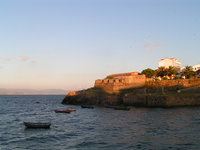
Finisterre
on the Atlantic coast of Galicia
Inland,
the region is less populated and suffers from migration
to the coast and the major cities of Spain. There are
few towns and there are many small villages. The terrain
is made up of several low mountain ranges crossed by
many small rivers that are not navigable but have
provided hydroelectric power from the many dams. Galicia
has so many small rivers that it has been called the
"land of the thousand rivers." The most
important of the rivers are the Miño and the Sil, which
has a spectacular canyon.
Lugo is a city in northwestern Spain, the capital of the
province of Lugo in the autonomous community of Galicia
in Spain.
Although
the region is filled with extensive natural areas,
Galicia has had environmental problems in the modern
age. Deforestation is an issue in many areas, as is the
continual spread of the invasive eucalyptus tree,
imported for the paper industry, which is causing
imbalances in the indigenous ecosystem. Fauna, most
notably the European wolf, have suffered from livestock
owners and farmers. The native deer species have
declined because of hunting and development. Recently,
oil spills have become a major issue, especially with
the Mar Egeo disaster in A Coruña and the infamous
Prestige spill in 2002, a crude oil spill larger than
the Exxon Valdez disaster in Alaska. Other environmental
issues include gas flushing by maritime traffic,
pollution from fish hatcheries on the coast, overfishing.
ECONOMY
Galicia
is a land of economic contrast. While the western coast,
with its major population centres, and its fishing and
manufacturing industries is prosperous and increasing in
population, the rural hinterland—the provinces of
Ourense and Lugo—base mostly their economy on
traditional agriculture, based on small landholdings
called minifundios. However, the rise of tourism,
sustainable forestry and organic and traditional
agriculture are bringing other possibilities to the
Galician economy without compromising the preservation
of the natural resources and the local culture.
Ourense (Galician: Ourense; Spanish: Orense) is a town
in northwestern Spain, the capital of the province of
Ourense in Galicia. Lugo
is a city in northwestern Spain, the capital of the
province of Lugo in the autonomous community of Galicia
in Spain.
HISTORY
The
name Galicia (Galiza) comes from Latin name Gallaecia,
associated to the name of the ancient Celtic tribe that
resided above the Douro river. The
Douro at Oporto Douro is one of the major rivers of
Spain and Portugal, flowing from its source near Soria
across central Spain and Portugal to its outlet at
Oporto.
Before
the Roman invasion, a series of tribes lived on the
region, having — according to Strabo, Pliny, Herodotus
and others — a similar culture and customs. These
tribes appear to have Celtic culture — there is
evidence that the last Galician Celtic speaker died in
the 15th century. Strabo
(squinty) was a term employed by the Romans for anyone
whose eyes were distorted or deformed.
The
region was first entered by the Roman legions under
Decimus Junius Brutus in 137 BC/136 BC.
In
the 5th century AD invasions, Galicia fell to the Suevi
in 411, who formed there the Kingdom of Galicia. In 584,
the Visigothic King Leovigild invaded the Suebic kingdom
of Galicia and defeated it, bringing it under Visigoth
control. During the Moorish invasion of Spain, the Moors
briefly occupied Galicia until they were driven out in
739 by Alfonso I of Asturias.
Galician
nationalist and federalist movements arose in the
nineteenth century, and after the Spanish Republic was
declared in 1931, Galicia approved in referendum an
Autonomy Statute for becoming as an autonomous region.
In 1936, Francisco Franco - a Galician from Ferrol
himself - came to power in Spain and removed Galicia's
such autonomy. He also tried to suppress the Galician
language and culture. During the last decade of Franco's
rule, renewed nationalist sentiment built up in Galicia.
In
1975, Franco died and democracy was restored to Spain
soon after. Galicia became an autonomous region within
Spain. There remains, however, a strong autonomist
movement, the Bloque Nacionalista Galego, that seeks
greater autonomy from the Spanish state, the
preservation of Galician heritage and culture. Some
factions advocate total independence from Spain and
other smaller groups hope to be reintegrated within
Portugal and the Portuguese-speaking world.
Presently,
Galicia is an autonomous community inside the Spanish
State, with its own parliament and health service.
Galicia, is a historical nationality, constituted as
Autonomic Community acceding this way to a extended self
ruling status under the Spaniard Constitution of1978.
...
ABOUT
THE VOLVO OCEAN RACE
The
Volvo Ocean Race is the ultimate mix of world class
sporting competition and on the edge
adventure. It takes 8 months, covers 31,000
nautical miles of treacherous seas over 9 legs, in the
process visiting 10 ports around the world.
The
teams comprise professional sportsmen and women at the
top of their game. The race requires their utmost skill,
physical endurance and competitive spirit as they race
from continent to continent in an easterly direction
around the world.
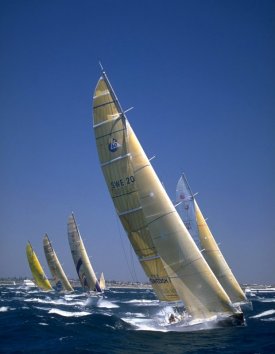
Round
The World Yacht Race 2005 - 2006:
The
Volvo Ocean Race is a marathon event. For nine months,
world-class racers battle each other around the globe
over some 32,700 miles (52,600 kilometers). Participants
spend weeks at a time driving their boats to the limit
24 hours a day. They sacrifice sleep, privacy, fresh
food, and other comforts to win each leg. But what
happens when they reach the next port of call?
The
race doesn't stop-it just shifts gears. Weary sailors
get a chance to rest and prepare for the next leg, while
the shore crew swings into action. After weeks of
demanding action, and a spartan existence at sea, the
first things these exhausted sailors crave are basic
human needs.
The
event will start on November 5, 2005 with an inport race
in Sanxenxo, Galicia, Spain.
The
race track will continue to follow the traditional route
of the old clipper ships, sailing around the world with
the prevailing winds. An
exciting new feature introduced for this event is a
number of scoring gates and pit stops around the world,
where the fleet will be able to score points, which will
count towards the final score.
RACE
HISTORY
It
is unlikely that Colonel Bill Whitbread, of the brewing
family and Admiral Otto Steiner, of the Royal Naval
Sailing Association, ever envisaged the magnitude of the
event they conceived 'over a pint' of beer nearly 30
years ago. Although
a 'round the world yacht race' had been considered
throughout the last century, it needed the financial
support and organisational expertise which Whitbread and
the RNSA were able to put together. The first Whitbread
Round the World Race, which got underway in September
1973, featured yachts that were little different from
those cruising around the Mediterranean at the time.
Since then, the ocean racing yacht has developed into a
high-tech state-of-the-art speed machine, with little
comfort spared for the crew but with leading-edge
technology.
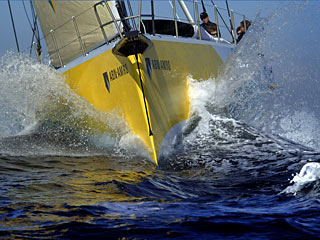
This
new technology has also completely altered the concept
of ocean racing. In the past, skippers and navigators
had little idea of where their rivals might be as they
ploughed day in day out through the vast oceans. During
the first race, communication between the fleet and
organisers was based on a weekly position report to a
local coast guard, but from 1993-94, satellite equipment
enabled the yachts to file their position every six
hours. This meant that although boats were not
necessarily in sight of each other, rival skippers were
able to follow, and track, every move when necessary. In
effect, this vast ocean race, where yachts can race for
days on end for thousands of miles and not once see
another competitor, has become, in this sense, more like
a fiercely fought dinghy race performed on any local
stretch of water.
The
Volvo Ocean Race simply could not have been a better
sporting event, but, just as importantly, it also became
a great media event. The payback in terms of media
coverage was hugely successful for all the teams and
their sponsors, which, for the future of the race, was
imperative. Based on this overwhelming success, the
management of Volvo Car Corporation and AB Volvo
confirmed during the Gothenburg stopover that they would
retain ownership of the event, which would be run again
in 2005.
A
Corinthian adventure 1973-74
When
the first gun was fired on September 8 1973, 17 boats of
sizes ranging from 80' to 32' from seven countries
crossed the start line just east of Portsmouth Harbour,
but only 14 were to complete the circumnavigation. Sir
Alec Rose, who, five years previously, had sailed around
the world, single-handed, stopping only twice, fired the
first-ever starting gun. Only four legs were staged -
Portsmouth to Cape Town; Cape Town to Sydney; Sydney to
Rio de Janeiro and from Rio the fleet raced back to
Portsmouth. The
whole race lasted 144 days with the 77' Ketch, Great
Britain II, skippered by Chay Blyth and crewed by
paratroopers, first to finish on 9 April 1974.
Safety first 1977-78
Tragedies
apart, the race was a huge success, and one of the main
lessons learnt for the next race was that survival in
these most exacting conditions were just as important as
speed. Whitbread renewed their sponsorship and it was
decided to repeat the event every four years. The next
race ran from August 1977 to March 1978 and again staged
four legs, only this time the port of Auckland was used
instead of Sydney.
Flyer's encore 1981-82
Cornelis
van Rietschoten returned on a new Flyer, which was 76'
in length, with the specific aim to win the race on both
elapsed and corrected time. This he achieved, crossing
the finish line 119 days after the fleet had set out
from Portsmouth in August 1981. Four legs were once
again staged but instead of Rio de Janeiro, the third
port of call was Mar de Plata, in Argentina.
Strength of quality 1985-86
A
smaller entry of 15 yachts from 10 countries entered the
fourth Whitbread, but lack of quantity was more than
made up for in strength of quality with all the yachts,
including the new 80' maxis, being specifically built
for this or an earlier race. Once again four legs were
staged, but Mar del Plata was replaced by Punta del Este
in Uruguay. This was also the last time for some years
that a South African port, Cape Town, was used, although
it was reinstated as a stopover port in the 1997-98
race.
'Big Red' 1989-90
The
1989-90 race will long be remembered as the time when
the event came of age in terms of the massive publicity
it achieved for the remarkable feat of seamanship shown
by New Zealand's Peter Blake. Blake, on the 84' Bruce
Farr designed ketch, Steinlager, claimed line honours on
every one of the six legs. The race was also notable for
the fact there was the first all-women entry, skippered
by Tracy Edwards, on the 58' sloop, Maiden. It was also
the first time six legs were staged.
Rewriting the record books 1993-94
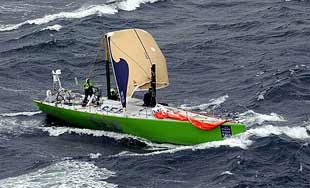
The
1993-94 Whitbread generated more interest than ever
before, with a new class of 'box rule' flat out ocean
racers being introduced. Maxi yachts were still
permitted and raced as a class, with the new W60 yachts
also racing as a separate division. The course remained
the same as the previous race and was keenly contested
for the much-prized Heineken Trophy awarded to the
overall winners in each division. Five Maxis and ten of
the new Whitbread 60 class crossed the start line (one
of the 60s, Odessa did not actually cross the start line
until just over one week after the gun). Two days into
the race, however, the maxi Fortuna skippered by
Britain's Lawrie Smith had to withdraw after suffering a
broken mizzenmast.
The Volvo Trophy 1997-98
The
seventh and final race under the Whitbread banner
changed the public face of ocean racing forever. The
sheer excellence of the on board video footage and the
quality and quantity of the daily emails from the crews
ensured a huge media interest worldwide. In turn, this
provided entertainment for the millions of sailing fans
around the world and a whole new audience was introduced
to the thrills of ocean water racing via the Internet.
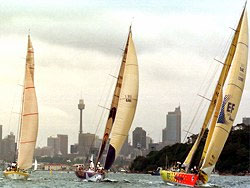
Aside
from the 35 weekly half hour television programmes
produced by Trans World International, the race had its
own web site, produced by Quokka Sports. On busy days,
such as restarts, this web site recorded around 13
million hits, surpassing even the New York Stock
Exchange.
The Volvo Ocean Race 2001-2002
Eight
teams, including an all female team, were on the Royal
Yacht Squadron starting line on September 23 2001 for
the 2001-2002 edition of the race. The Whitbread had
successfully been transformed into the Volvo Ocean Race
and the 32,250-mile race around the world started from
Southampton on the south coast of England and finished
in style in Kiel Germany. After 32,700 nautical
miles, four oceans, nine countries, and ten ports, the
German boat illbruck returned home today as the winner
of the marathon Volvo Ocean Race.
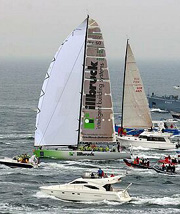
|